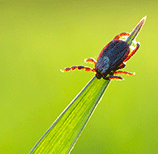Lyme disease is something you should know about, and Dr. Justine Lee is here to help. For more from Dr. Lee, find her on Facebook!
Ah, Lyme disease. Not only is it the #1 mispronounced disease of the summer (it’s Lyme, not Lymes disease, folks!), but it’s probably the #1 misdiagnosed disease out there, too. The Gram-negative spirochete (bacteria-like) organism that causes it, Borrelia burgdorferi, was originally discovered in Old Lyme, Connecticut in the mid-70s. Nowadays, over 95% of the cases of human Lyme disease come from Connecticut, Delaware, Maine, Massachusetts, Maryland, Minnesota, New Hampshire, New Jersey, New York, Pennsylvania, Vermont, Virginia, and Wisconsin. Regardless of what state you live in, pay attention, as this disease can be devastating to your dog.
Thankfully, cats are rarely affected by Lyme disease. Why? It’s likely because they are such fastidious groomers that those ticks don’t have a chance of attaching on!
 So, what exactly is Lyme disease?
So, what exactly is Lyme disease?
Lyme disease, an infection that causes shifting-leg lameness, arthritis, joint swelling, fever, platelet abnormalities, and rare heart arrhythmias, is usually transmitted by the Ixodes deer tick (Ixodes scapularis or I. pacificus). In severe cases, it can cause protein loss through the kidneys (called protein-losing nephropathy or “PLN”), resulting in fatal kidney failure – this is particularly common in Golden Retrievers and Labradors.
Next week, I’ll talk about how to go about diagnosing Lyme disease – it’s more complicated than you think, and it’s important to know what a “positive” Lyme test really means. We’ll also focus on how, and if, we should be treating it.
How do I prevent my dog from getting Lyme disease?
When in doubt, prevention is the key. Prevention includes tick-picking (fun!), flea and tick medication, and even vaccination.
While tick-picking isn’t the most reliable way to stay Lyme free (as nymphs are as small as the point of a pencil), make sure to check your pet (and you!) carefully after a walk in the woods. Check the inside thighs, the ears, and the trunk of the belly, where these tiny ticks like to hide… and then do it again the next day. If a tick bites your dog, the tick will be big enough to find by then. Remember, it takes about 24-48 hours for a tick to transmit Lyme disease, so you have a narrow window to find and pull those plump ticks off. Simply use a pair of fine-tipped tweezers to grasp the tick as close to the skin as you can and pull upwards with steady pressure. Do not twist or jerk while pulling as this may cause the head to break off, remaining in the skin.
While there is a Lyme vaccine available for dogs, I don’t typically recommend vaccinating for Lyme unless you live in one of the above-mentioned states; you own a hunting dog; or you’re both off hiking in the woods frequently. If you live in a deer-free area, or aren’t in one of the aforementioned states before, then your dog doesn’t typically need the Lyme vaccine. Instead, use preventatives like monthly prescription-strength tick preventative (like Frontline, Advantix, etc.). If you’re in a severely tick infested area, I also use these in conjunction with an additional prescription-strength tick collar (e.g., Preventic or Seresto) too – especially if your dog is at high risk!
When in doubt, prevention is really important with Lyme disease. As I’m based out of Minnesota, and just picked two ticks off my dog yesterday, I often see the devastating and potentially fatal effects of PLN, and it’s not worth risking exposure to your dog.
Source:
- Littman MP, Goldstein RF, Labato MA, et al. ACVIM small animal consensus statement on Lyme disease in dogs: Diagnosis, treatment, and prevention. J Vet Intern Med 2006;20(2):422-34.
If you have any questions or concerns, you should always visit or call your veterinarian – they are your best resource to ensure the health and well-being of your pets.
Your Dog and the Dangers of Lyme Disease: Part II>>

